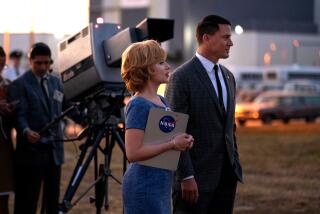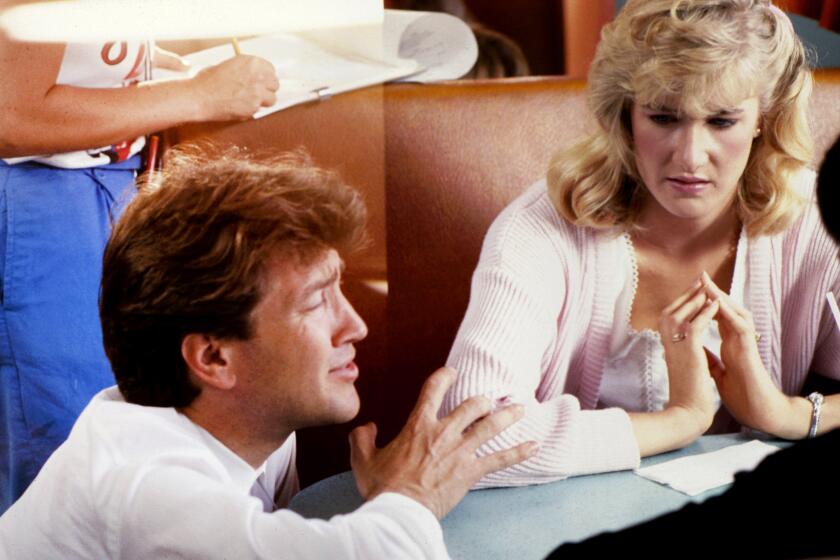And yet will it rise?
- Share via
The old saw about undistinguished books making the best movie adaptations might easily be applied to the current vogue for remaking pictures as well.
Though perhaps it is better to say “less well-known,” such as the case with 1965’s “The Flight of the Phoenix,” a film that few would label a mint-condition classic but is nevertheless a solid and engaging drama about a group of plane crash survivors struggling to survive in the desert.
“It’s definitely easier to remake a picture that’s not as well known,” explains William Aldrich, a producer of the new “Flight of the Phoenix” and whose late father, the legendary Robert Aldrich, directed the original. “The surprises and twists are fresher and new to people.”
The remake stars Dennis Quaid as Frank Towns, the captain of a well-worn, recycled C-119 military cargo plane, who is sent to evacuate Miranda Otto’s Kelly, chief roustabout of an oil rig in the Tan sag Basin in Mongolia, and her crew. When an epic sandstorm hits, Towns is forced to crash-land the plane in the middle of the desolate Gobi Desert at the height of summer -- placing everyone’s life in danger.
Director John Moore had a passing familiarity with the original -- and kept it that way even after he took on the project. “I’ve never seen it in its entirety. I have what I refer to a Saturday afternoon recollection of it from television. It’s one of those films that most people think they’ve seen.”
Speaking a few days after the remake opened Friday in Los Angeles to a lackluster box office, Moore’s comments had a tinge of depression and therapeutic venting to them.
“The original film, like ours, didn’t do very well when it first opened,” says Moore. “But over time it found this sort of begrudging audience. So it wasn’t like you were going to remake something that was such a Holy Grail, that was sacrosanct and you were going to get in trouble for. I think the story, because it is such a basic story about survival and hope, I think it was OK territory to go into.”
The remake project began with Aldrich, who shared the rights to the original along with 20th Century Fox, about nine years ago. Over the course of many drafts and multiple writers, one of the biggest hurdles for the production to overcome was just how much to modernize the story. Lost in the desert is lost in the desert, after all, no matter the year.
“There were moments when you had concern,” explains Moore. “Is this going to feel period or is it timeless? Should we do something to modernize it? There’s a scene with an iPod that 10 years from now is going to look hopelessly dated, like, ‘What were they thinking?’
“I personally didn’t have as many concerns. I felt you could set it in caveman times or in the future and it would still be a good story. It would be untruthful for me to say there weren’t ongoing concerns why people should care about it and how do you apply some sort of modernity to it.”
One way in which he threw those concerns to the wind was in how he created the sandstorm and plane crash that motivates the ensuing drama.
Rather than exclusively using computer-generated special effects, he chose instead to rely as much as possible on more old-fashioned techniques.
“We did most of our major effects work with miniatures,” he says. “And miniature photography and model making, I’m telling you, it’s going to die. I’m a big believer in photography, so we went to a great level of effort to use more traditional methods, but our visual effects supervisor literally had to pull out his little black book to find a guy who still does this. It wasn’t easy.”
Moore bristles at references to his remake of “Flight of the Phoenix” as an “action” film.
“It does seem to cheapen it a little,” he says. “Personally, I think it’s a good drama. But drama means not costing very much and getting Oscar nominations for people to go see it.
“And this was not the most expensive film to make, but it did cost a chunk of change. And I agree it’s a backhanded compliment to call it an action film in which there’s only one action sequence.
“It was too expensive to be marketed solely as a drama. Which I think is fair enough.”
Following the inevitable second-guessing and self-doubt, what producer Aldrich jokingly refers to as “postpartum depression,” there is the hope that they have created something for the ages. In the end, Aldrich’s main concern lay with perhaps his toughest potential critic of all.
“My fear about my father spinning in his grave,” he jokes, “I don’t have anymore.”
More to Read
Only good movies
Get the Indie Focus newsletter, Mark Olsen's weekly guide to the world of cinema.
You may occasionally receive promotional content from the Los Angeles Times.











